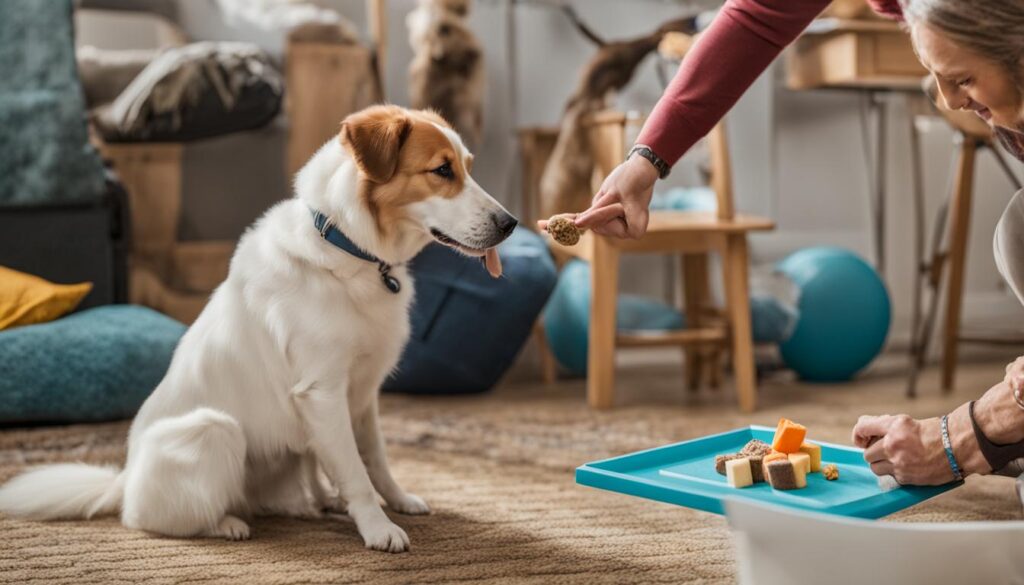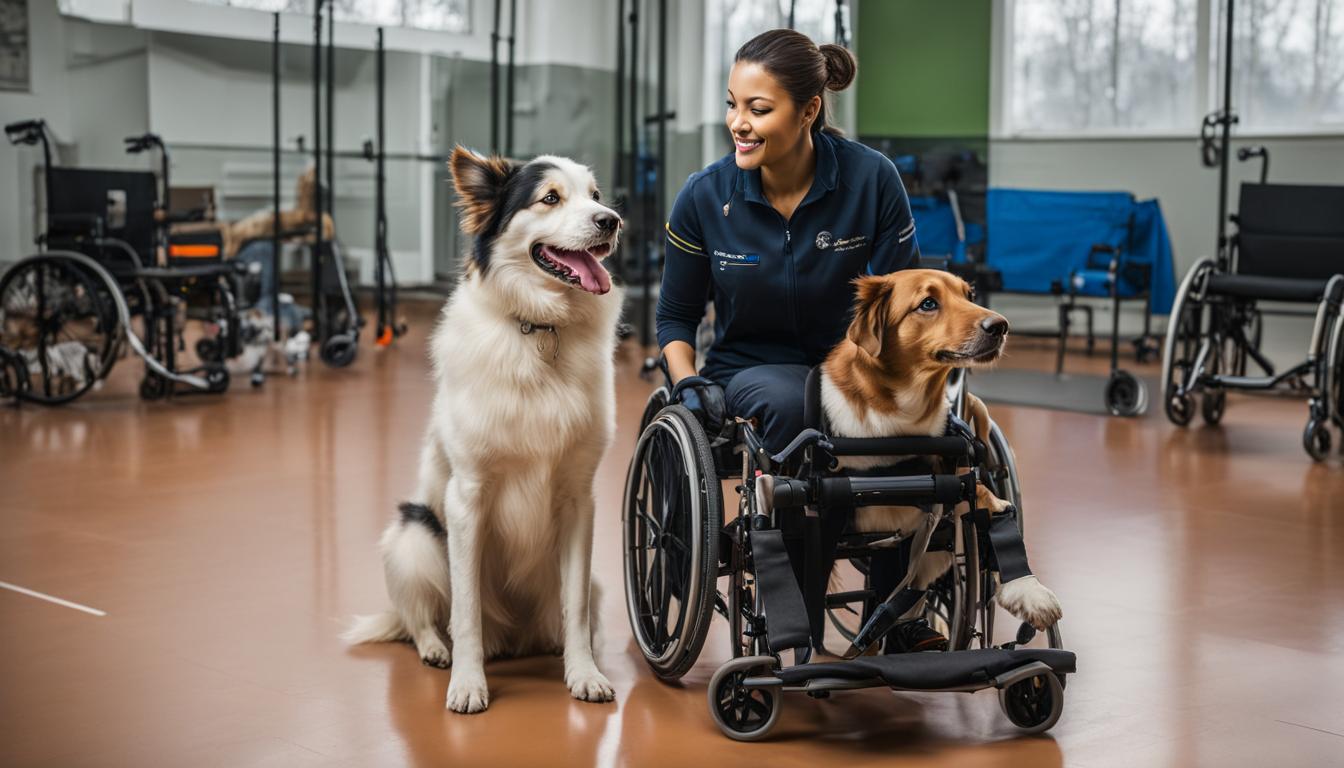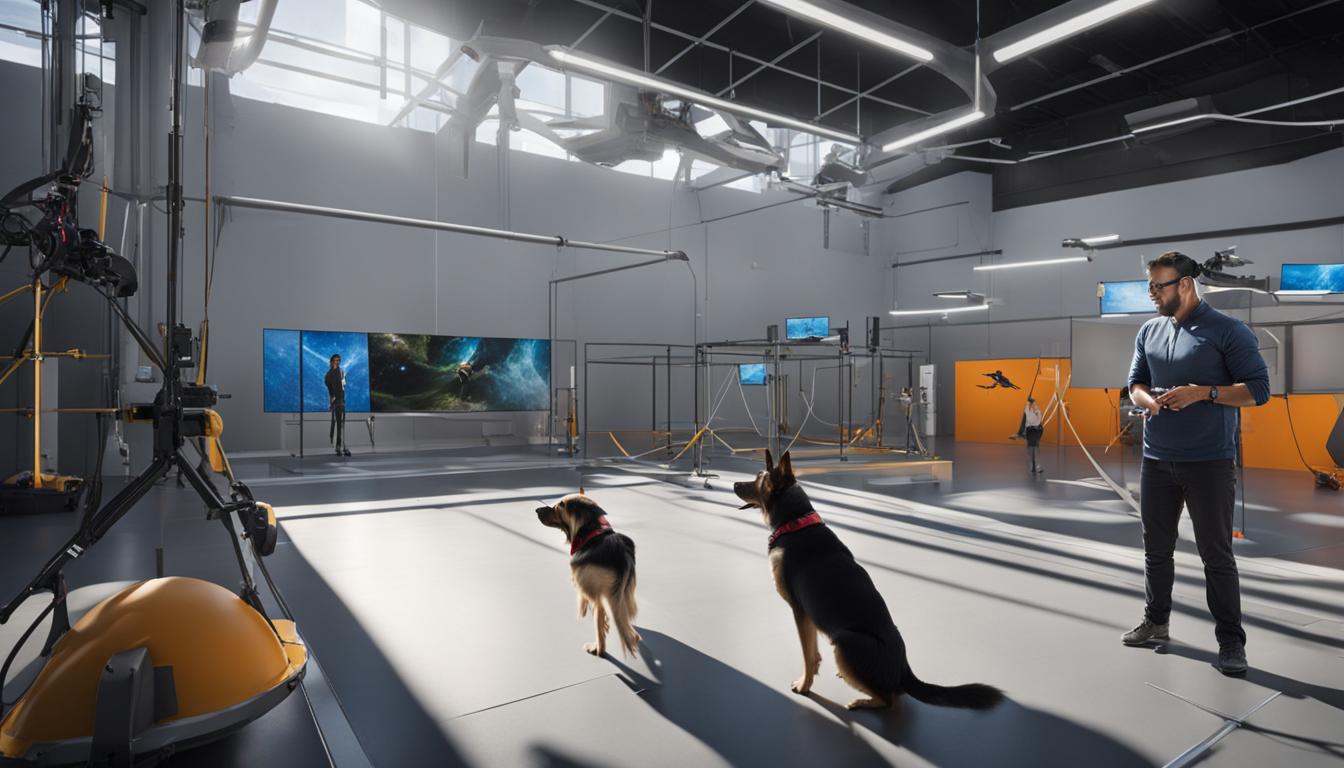Training dogs with disabilities requires a specialized approach to accommodate their unique needs and abilities. Whether your dog has a visual impairment, hearing disability, mobility issue, or sensory disability, there are specific techniques and training methods that can be effective. Understanding your dog’s specific disability and limitations is crucial in providing effective training and communication.
Key Takeaways:
- Training dogs with disabilities requires specialized techniques and adaptations.
- Understanding the dog’s specific disability and limitations is essential for effective training.
- Tailoring training sessions to the dog’s capabilities and keeping them engaging but not overwhelming is important.
- Using positive reinforcement and appropriate tools can enhance the training process for disabled dogs.
- Training dogs with disabilities improves their behavior, obedience, and overall quality of life.
Understanding Dog Disabilities and their Causes
Dogs, just like humans, can experience disabilities that affect their daily lives. These disabilities can be caused by a variety of factors, including congenital conditions, diseases, injuries, or age-related issues. Dogs with disabilities require special attention and care to ensure they can still lead happy and fulfilling lives. Understanding the causes of these disabilities is crucial in providing the appropriate support and training for these furry friends.
There are several common disabilities that dogs may experience. Visual impairments can occur due to genetic conditions, cataracts, or trauma to the eyes. Hearing disabilities may result from congenital deafness or age-related hearing loss. Mobility issues can be caused by injuries, arthritis, or neurological conditions. Sensory disabilities, such as loss of smell or touch, can stem from various health conditions.
It is important to note that disabilities can manifest differently in each dog. Some disabilities may be present from birth, while others may develop over time. Each dog’s disability is unique, and understanding the specific limitations and challenges associated with their disability is essential in providing effective training and support.
| Disability | Causes |
|---|---|
| Visual Impairments | Congenital conditions, cataracts, trauma |
| Hearing Disabilities | Congenital deafness, age-related hearing loss |
| Mobility Issues | Injuries, arthritis, neurological conditions |
| Sensory Disabilities | Health conditions affecting smell or touch |
By understanding the causes of dog disabilities, owners and trainers can develop appropriate training techniques and create a safe and supportive environment for their furry companions. Whether it’s using visual cues for visually impaired dogs, sign language for hearing-impaired dogs, or providing assistive devices for dogs with mobility issues, adapting training methods to accommodate their disabilities can improve their quality of life and strengthen the bond between dogs and their human companions.
Communication Techniques for Disabled Dogs
When it comes to training dogs with disabilities, effective communication is crucial. Since dogs primarily rely on body language and sounds to communicate, it is essential to adapt communication techniques to accommodate their specific needs. Whether your dog has a visual impairment, hearing disability, mobility issue, or sensory disability, there are various approaches you can use to effectively communicate and train them.
For deaf dogs, hand signals can be a great way to convey commands and cues. By using consistent hand gestures, you can establish a clear means of communication that your dog can quickly learn. On the other hand, blind dogs benefit from different sound cues that help them navigate their environment. By using a combination of visual and audio signals, you can stimulate their minds and promote their overall well-being.
During training sessions, it’s important to observe your dog’s responses and make adjustments accordingly. Each dog is unique, and what works for one may not work for another. By paying attention to your dog’s body language and behavior, you can tailor your communication approach to their specific needs. Clear and consistent communication is key to training disabled dogs effectively.
Benefits of Effective Communication Techniques
- Establishes a strong bond between you and your dog
- Helps your dog feel secure and confident
- Promotes mental and physical stimulation
- Enhances overall well-being and happiness
By using effective communication techniques, you can make training sessions more engaging, enjoyable, and rewarding for both you and your disabled dog. Remember to be patient, understanding, and consistent as you navigate the unique challenges and opportunities that come with training a dog with disabilities.

Training Techniques for Dogs with Visual Impairments
Dogs with visual impairments require specialized training techniques to help them navigate their surroundings and overcome their disability. By focusing on verbal cues and sound signals, you can effectively communicate with these dogs and teach them a variety of commands.
One effective technique is to associate specific sounds with different commands. For example, you can use a clicker or a whistle to signal a “sit” command, and a different sound for a “stay” command. By consistently using these auditory cues during training sessions, dogs with visual impairments can quickly learn to recognize and respond to each command.
Training sessions should take place in familiar and safe environments to minimize potential hazards. It’s important to create a consistent routine and provide clear guidance to help these dogs navigate their surroundings with confidence. Additionally, using tools like head collars or halos can assist blind dogs in safely exploring new spaces without bumping into objects.
| Training Techniques for Dogs with Visual Impairments | Benefits |
|---|---|
| Use verbal cues or sound signals | Allows dogs to associate specific sounds with commands |
| Create a consistent routine | Helps dogs navigate their surroundings with confidence |
| Utilize tools like head collars or halos | Assists blind dogs in exploring new spaces safely |
| Provide positive reinforcement | Encourages dogs to learn and respond to commands |
During training sessions, it’s crucial to use positive reinforcement to motivate and reward dogs for their progress. Offer treats, praise, and affection as a way to reinforce desired behaviors. Patience and consistency are key, as dogs with visual impairments may require more time to fully understand and execute commands.
With the right training techniques and a supportive environment, dogs with visual impairments can lead fulfilling and happy lives, full of love and companionship.
Effective Training for Dogs with Hearing Disabilities
Dogs with hearing disabilities require special training techniques to ensure effective communication and obedience. By tailoring the training methods to accommodate their unique needs, you can help them lead fulfilling lives and strengthen the bond between you and your furry friend. Here are some tips for training dogs with hearing disabilities:
Hand Signals and Visual Cues
Since dogs with hearing disabilities cannot rely on verbal commands, using hand signals and visual cues is essential. Train your dog to associate specific hand gestures with different commands or actions. Keep the signals clear, distinct, and easy to understand to ensure effective communication.
Combining Visual and Audio Signals
For dogs with partial hearing loss, combining visual and audio signals can be beneficial. Use a combination of hand signals and distinct sounds to communicate commands and reinforce training. This approach stimulates their senses and increases the chances of them understanding and following instructions.
Effective training for dogs with hearing disabilities involves positive reinforcement, consistency, and patience. Celebrate their successes and reward them with treats, praise, or playtime to motivate and encourage their learning. Consistency is key in establishing routines and reinforcing desired behaviors. Remember, every dog is unique, so tailor the training process to suit their individual needs and abilities.

| Training Tips for Dogs with Hearing Disabilities | Benefits |
|---|---|
| Use hand signals and visual cues | – Facilitates communication – Enhances understanding – Strengthens the bond |
| Combine visual and audio signals | – Increases responsiveness – Stimulates their senses – Reinforces training |
| Positive reinforcement and consistency | – Motivates and encourages learning – Establishes routines – Builds trust and confidence |
By using these effective training techniques, you can ensure that dogs with hearing disabilities can understand and follow commands, leading to a happy and well-trained companion. Remember to consult with professional trainers or behaviorists who specialize in training dogs with disabilities for additional guidance and support.
Customized Training for Dogs with Mobility Issues
Dogs with mobility issues require specialized training techniques to help them overcome their physical challenges and navigate their environment with confidence. Whether a dog has a limb deformity, arthritis, or is recovering from surgery, customized training can improve their mobility and overall quality of life. By tailoring training methods to their specific needs, you can ensure that they receive the support and guidance necessary to thrive.
One effective training technique for dogs with mobility issues is the use of assistive devices such as dog carts or splints. These tools can provide the necessary support and stability for dogs to move comfortably and independently. Introducing dogs to these devices should be done gradually, allowing them to adjust and become familiar with them over time. With patience and positive reinforcement, dogs can learn to rely on these devices and regain their mobility.
In addition to assistive devices, focusing on exercises that target the dog’s remaining muscles can help improve their strength and coordination. These exercises may include gentle stretches, balance exercises, and controlled movements that promote muscle development. Incorporating these exercises into their training regimen can help dogs build strength and maintain their mobility.
Example Exercise Routine for Dogs with Mobility Issues:
- Warm-up exercises: Start with a short walk or gentle stretching to warm up the dog’s muscles.
- Balance exercises: Use a balance disc or a balance board to improve coordination and stability.
- Strength-building exercises: Incorporate exercises that target the dog’s remaining muscles, such as sit-to-stand exercises or gentle resistance training.
- Low-impact activities: Engage in activities that minimize stress on the dog’s joints, such as swimming or hydrotherapy.
- Cool-down: End the exercise session with a short walk or gentle stretching to cool down the dog’s muscles.
Remember, it is important to consult with a veterinarian or a professional dog trainer before starting any training regimen for a dog with mobility issues. They can provide expert guidance and ensure that the training program is safe and appropriate for the dog’s specific needs. With patience, consistency, and customized training techniques, dogs with mobility issues can lead happy, active lives.

Behavioral Training for Dogs with Special Needs
When it comes to dogs with special needs, behavioral training plays a crucial role in addressing any unwanted behaviors they may exhibit. Whether it’s aggression, fear, anxiety, or excessive barking, the right training techniques can help modify and reshape these behaviors, promoting a happier and more fulfilling life for both the dog and their human companions.
One effective approach is using positive reinforcement, which involves rewarding desired behaviors with treats, praise, or playtime. This helps to motivate and encourage the dog to repeat those behaviors in the future. Consistency is key in behavioral training, as dogs thrive on routine and clear expectations. By setting consistent boundaries and providing appropriate guidance, dogs with special needs can learn to overcome their challenges and develop more positive behaviors.
In some cases, it may be beneficial to seek the guidance of a professional trainer who specializes in working with dogs with special needs. A professional can provide expert advice on training techniques that are tailored to the specific needs of the dog, offering valuable insights and strategies for addressing their behavioral issues. Additionally, a trainer can help educate owners on how to effectively communicate with their dog and create a nurturing environment that promotes positive behaviors and a sense of security.
“Behavioral training is essential for dogs with special needs. By focusing on positive reinforcement and consistency, we can help these dogs overcome behavioral challenges and live happier lives.”
Enhancing Quality of Life Through Training for Disabled Dogs
Training dogs with disabilities is not only about improving their behavior and obedience; it is also about enhancing their overall quality of life. By providing specialized training, you can help these dogs develop a stronger bond with their owners, gain independence, and overcome the obstacles that come with their disabilities.
Through training, disabled dogs receive mental and physical stimulation, promoting their well-being and happiness. It allows them to stay mentally sharp and physically fit, even with their limitations. By engaging their minds and bodies, training helps disabled dogs lead fulfilling lives and enjoy a sense of accomplishment.
Moreover, keeping veterinarians and dog behavior experts informed about the progress of the training is crucial. This ensures that the dog’s specific needs are met and any adjustments can be made to the training program. By working together, you can create a comprehensive training plan that caters to the unique abilities and challenges of your disabled dog.
So, don’t underestimate the power of training in improving the quality of life for disabled dogs. With the right approach and techniques, these amazing companions can thrive and bring immense joy to your life. Start training your disabled dog today and unlock their full potential!
FAQ
What are some specialized training approaches for dogs with disabilities?
Training dogs with disabilities requires a specialized approach that accommodates their unique needs and abilities. Techniques such as positive reinforcement and the use of appropriate tools can enhance the training process for disabled dogs. It is important to tailor training sessions to the dog’s capabilities and keep them engaging but not overwhelming.
What are the causes of dog disabilities?
Dogs can have disabilities for various reasons, including congenital conditions, diseases, injuries, or age-related issues. It is important to gain a deeper understanding of the dog’s disability, its causes, and its limitations. This knowledge helps to set realistic expectations, avoid pain points, and communicate effectively with the dog.
How can I communicate effectively with a disabled dog?
Dogs primarily communicate through body language and sounds. For deaf dogs, hand signals can be quickly and effectively learned, while blind dogs can differentiate between various sound cues. Using a combination of visual and audio signals can stimulate their minds and promote their overall well-being. Clear and consistent communication is key to training disabled dogs effectively.
What training techniques can I use for dogs with visual impairments?
Dogs with visual impairments can be trained using verbal cues or sound signals. They can learn to associate specific sounds with different commands, such as sit, stay, or come. Training sessions should take place in familiar and safe environments to minimize potential hazards. The use of tools like head collars or halos can assist blind dogs in navigating new spaces. Positive reinforcement and patience are essential in training dogs with visual impairments.
How can I effectively train a dog with hearing disabilities?
Dogs with hearing disabilities can be trained using hand signals or sign language. They are able to quickly learn to associate specific hand gestures with commands or actions. It is important to make the visual cues clear and easily distinguishable for the dog. Combining visual and audio signals can also be beneficial, especially for dogs with partial hearing loss. Positive reinforcement and consistency are key in training dogs with hearing disabilities.
What training techniques are best for dogs with mobility issues?
Dogs with mobility issues require customized training techniques to help them navigate their environment and perform daily tasks. The use of tools like dog carts or splints can assist them in moving around without pain. Training should focus on strengthening their remaining muscles and providing them with the support they need. Positive reinforcement and patience are crucial in training dogs with mobility issues.
How can I address behavioral issues in dogs with special needs?
Dogs with special needs may exhibit certain behavioral issues that require specific training approaches. This may include aggression, fear, anxiety, or excessive barking. Behavioral training aims to modify and reshape unwanted behaviors through positive reinforcement and redirection techniques. It is important to address these issues with patience, consistency, and the guidance of a professional trainer if necessary. Training should focus on promoting positive behaviors and providing the dog with a sense of security and confidence.
How can training enhance the quality of life for disabled dogs?
Training dogs with disabilities not only improves their behavior and obedience but also enhances their overall quality of life. Through training, disabled dogs can develop a stronger bond with their owners, gain independence, and overcome obstacles. Training provides mental and physical stimulation, promoting their well-being and happiness. It is important to update veterinarians and dog behavior experts on the progress of the training to ensure that the dog’s specific needs are met. With the right approach and training techniques, disabled dogs can thrive and enjoy a fulfilling life with their human companions.





